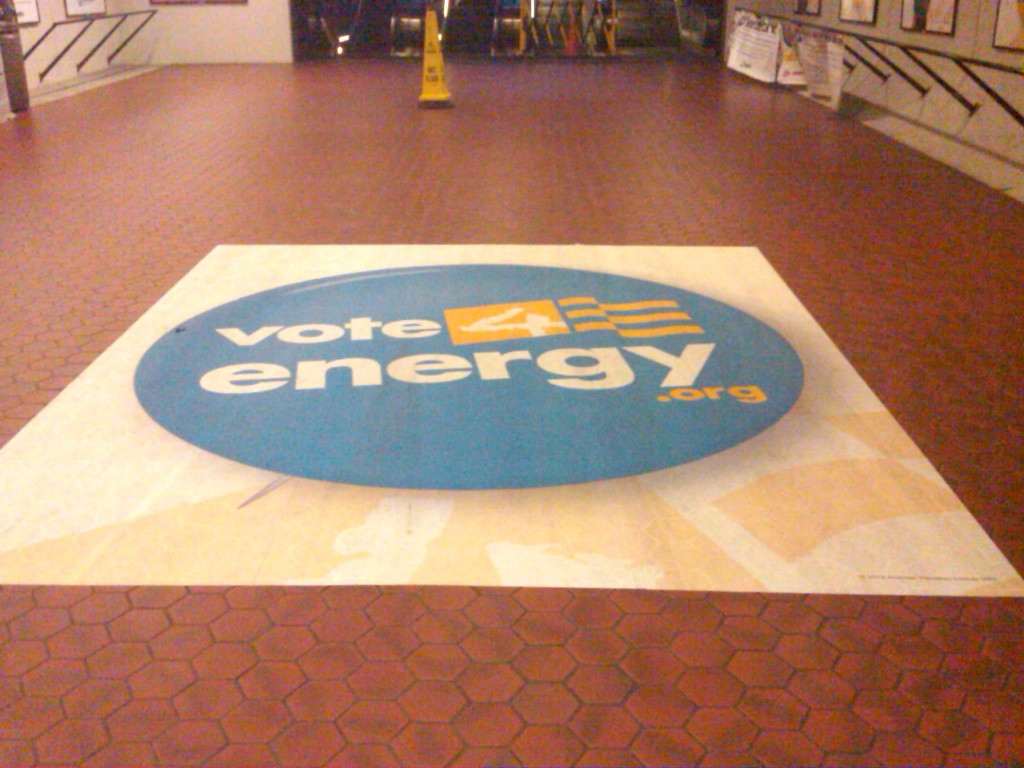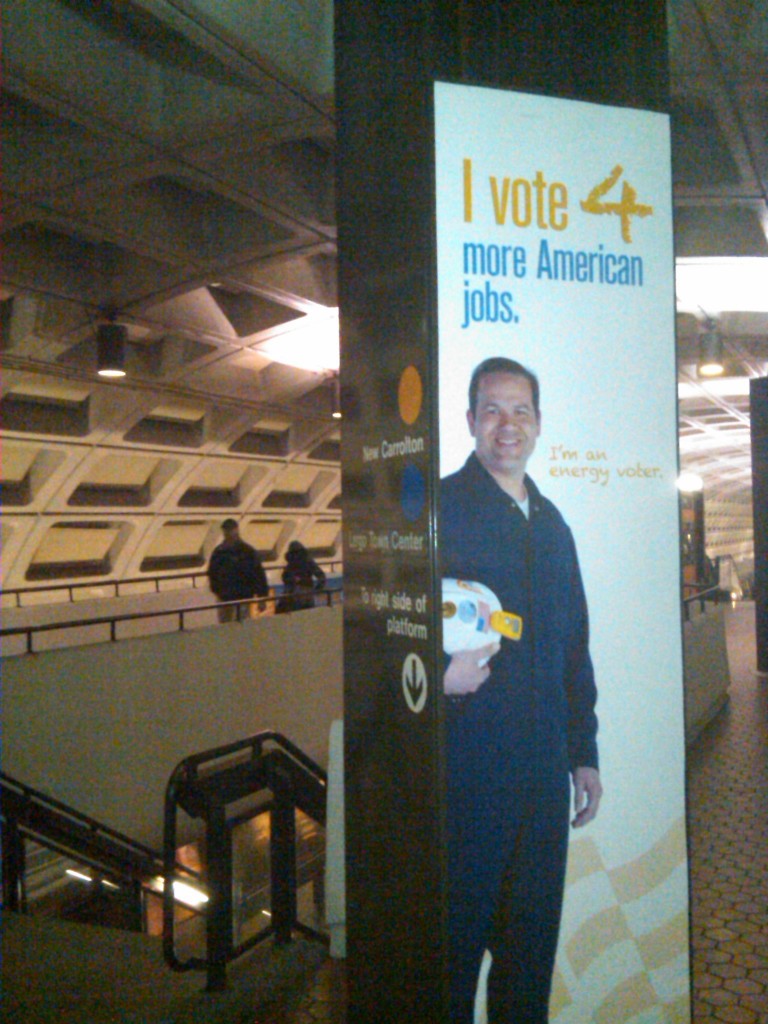When you get off the DC subway at the Capitol South metro stop and head up the escalator, you never really know what you are going to encounter at the top. Some days, it’s the pro-life protesters. Other days it’s the Lyndon Larouche crowd. Sometimes it’s religious proselytizers. Or a worker’s union. Or a conspiracy theory group. Occasionally it’s a charity raising money. And now and again it’s a protest or other group that you can’t even really discern. But there’s really never a week that goes by without some sort of organized group at the top of the Capitol South escalator, and in the nice weather it can be day after day with no perceivable end. It’s undoubtedly the most popular metro station at which to hold a political protest or conduct grassroots lobbying efforts.
The reason it’s so popular is pretty simple: location. Capitol South’s placement on 1st street SE between C street and D street is extremely close in proximity (less than 50 yards) to the three House Office Buildings, and not far at all from the Capitol Building. In addition, the station is directly across the street from the Republican National Committee headquarters and the National Republican Club. For comparison purposes, Union Station — which is the closest metro stop to the Senate side of the Capitol — is almost a quarter-mile from the Senate Office Buildings.
Consequently, three groups of attractive protest targets are heavy users of Capitol South and the surrounding 1st Street area. First, a large number of House staffers use the station as part of their daily commute. Second, GOP Members and party-related staff are constantly moving between the Hill and the RNC/NRC, as well as often congregating on the sidewalks out front of the NRC. Finally, a large number of tourists pass through Capitol South directly prior to going into one of the House Office Buildings to pay a visit to the office of their Representative in Congress.
Beyond proximity to the Hill, Capitol South has some unique features that make it even more advantageous as a spot to convey information. First, there’s a great signal-to-noise ratio; the vast majority of all the traffic coming up the escalator at Capitol South is heading toward the Hill for one reason or another, and there’s almost no reason to be a pedestrian on that block of 1st street if you aren’t going or coming from the Hill. Compare this to Union Station, where the vast majority of people passing through are not going to the Hill. Second, Capitol South only has one real exit (again, unlike Union Station); if you set your protest up at the top of the escalator, it’s basically impossible for anyone to get on or off the subway without receiving your message. Just about the only disadvantage of Capitol South (from the protestor point of view) is that it’s not a physically big area; you can’t fit more than a few dozen protestors in there before it becomes a complete mess.
All of this make the top of the Capitol South escalator a fine place to try to get your political message to people who might be in a direct position to influence political outcomes on the Hill: House staffers heading to work, party people heading from the Hill to the RNC, tourists who are about to go stop in at a Representative’s office, and so on. The causal mechanism isn’t rocket science: grassroots lobbying and protests need to be visible to policymakers and to those who can influence policy makers. Many groups are reliant on free media to cover their protests as a middleman, but one way to be visible is to skip the media and try to directly prime, either consciously or subconsciously, the policymakers and influencers themselves, on their way to the Hill. There’s no question that this is the strategy.
What is a question is how well this works? I often wonder coming out of Capitol South, do these protests actually influence staffers, or are the protestors just wasting their time? I go back and forth on the answer to that, and I think it probably has some effect. But even if you could say for sure, getting a firm grip on the magnitude of the effect is almost impossible: lobbying effectiveness in general is really difficult to measure, in part because we can’t ever use random-assignment to isolate the variable, but also because there’s no clear definition of what success means. It’s not like product advertising, where you have a bottom line of sales revenue for each product. In the world of Hill lobbying, you are almost always competing against an amorphous counterfactual, and therefore it’s never clear whether the claims made by any lobbying group are actual effectiveness or just goalpost-moving of the imagined alternative outcome.
On the other hand, it’s pretty obvious that those doing the protesting/lobbying outside of Capitol South believe that they are being effective. And there’s a neat little indirect way to (very roughly) ballpark some concrete numbers associated with those beliefs: the cost of advertising inside the Capitol South station. The DC Metro contracts with CBS Outdoors to sell advertising in all Metro subway stations. As described in their DC media kit and rate book, you can buy a variety of different kinds of subway advertising, including individual platform ads such as banners, posters, or floor graphics; rail car advertising such as interior posters or exterior branded cars, or packages that place your platform or rail advertising into many stations or whole fleets of rail cars. This should be familiar to anyone who has ridden the DC Metro, or any other metropolitan subway.
One other thing you can do is something called “station domination,” which allows you to buy up every single advertising spot in a given Metro station. A full station domination package is currently offered at ten DC stations: Capitol South, Metro Center, Convention Center-Mt Vernon, L-Enfant Plaza, Farragut North, Navy Yard, Pentagon, Regan Airport, Union Station, Federal Triangle, and Gallery Place. Looking at the Capitol South Station Domination factsheet, you can get a sense of how it works: you get a total of 45 advertisements, including two massive floor graphics, huge Pylon faces, dozens of monster-sized banners and platform ads, and a bunch of other stuff. As described by CBS Outdoor, the goal is “total station saturation. Creation of a total “experience” incorporating traditional media and non-traditional displays.” Station domination buys are offered in 4-week blocks.
Here’s the thing: station domination is ridiculously popular at Capitol South. Anyone who commutes through there will instantly recognize what I’m talking about: one day you get off the Metro, and every single sign is for the same defense contractor; a few weeks later, you come down the escalator and every single sign is for a green energy group. Most recently, I got off the subway car, and it was vote4energy.org that had decided to dominate the station. It really does dominate the station; these ads are huge. And they are everywhere. Here are some photos I took of the advertising:

One thing is worth reiterating: as mentioned above, none of this proves anything about the effectiveness of conducting lobbying or protest activities at Capitol South; at most it indicates that lobbying and protest groups believe there is strong value to conducting their activities there. But we kinda already knew that, intuitively. On the other hand, it’s quite striking to see the premium attached to the ad buys at Pentagon and Capitol South, relatively to the amazingly stable baseline cost at other major subway stops.



The station is also extremely close to Democratic National Headquarters.
Reading everything you write with great interest…keep up the good work.
gannon
The Pentagon saturation has backlighting… I am still not going to buy a Joint Strike Fighter.
The premium that people are willing to spend to get to Washington “influencers” is even more pronounced when you look at the rates of a DC-only buy on Meet the Press. The cost per eyeball is astronomical. There are a lot of shows on cable news with higher ratings than Meet the Press, but a national buy on those shows is cheaper than a local buy on Meet the Press in Washington.
Very cool data, Matt. Might use this in my class on Washington D.C. — illustrates the intersection of national politics and the Metro.
Pingback: Exit Strategy | Matt Glassman
Pingback: Assorted links — Marginal Revolution
Pingback: Assorted links | Bailout and Financial Crisis News
Of course how often do politicians actually take the subway? They should sell advertising to the limo drivers.
@mr.v- staffers write the politicians’ bills and speeches
Pingback: Links: iPhones and airports « City Block
The fact that, as your article explains, the Capitol South station is a target-rich environment — so there may well be a high premium on getting a political message out, but we can’t tell whether that is higher than the cost of getting, say, advertising for another good, product or idea out there on a per-target basis.
I feel that some of the people who are lobbying both Union Station and Capitol South would have a much better reception if they were not as aggressive and a little more polite.
Pingback: links I like | kimberly bowman
Pingback: At the corner of East Capitol and 1st Street NW | Matt Glassman